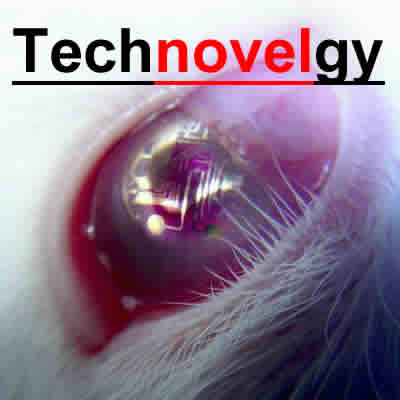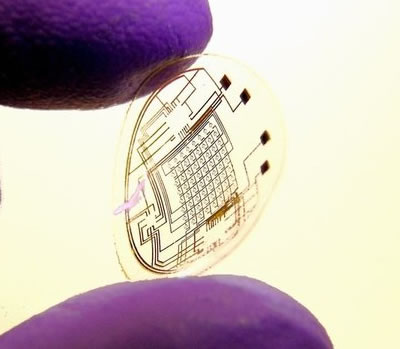Science Fiction
Dictionary
A B C D E F G H I J K L M N O P Q R S T U V W X Y Z
Circuit Smart Contact Lens, Presaged By Niven, Barnes and Vinge

Contact lenses with imprinted electronic circuits and lights for augmented reality display vision are under development by University of Washington scientists.

(Contact lens with circuits worn by rabbit)
The UW engineers used microscopic scale manufacturing techniques to create a flexible, biologically safe contact lens with imprinted electronic circuits and lights. If used by human beings, a pair of contact lenses with circuits and lights would be the perfect display for augmented reality systems.

(Contact lens with circuits close-up)
The prototype device contains an electric circuit as well as red light-emitting diodes for a display, though it does not yet light up. The lenses were tested on rabbits for up to 20 minutes and the animals showed no adverse effects.
"Looking through a completed lens, you would see what the display is generating superimposed on the world outside," said Babak Parviz, a UW assistant professor of electrical engineering. "This is a very small step toward that goal, but I think it's extremely promising."
Researchers built the circuits from layers of metal only a few nanometers thick, about one thousandth the width of a human hair, and constructed light-emitting diodes one third of a millimeter across. The researchers hope to power the whole system using a combination of radio-frequency power and solar cells placed on the lens.
Science fiction readers are fortunate to have had this idea presented to them several years ago. In his 2001 novella Fast Times at Fairmont High, sf writer, computer scientist and mathematician Vernor Vinge described a near-future world in which everyone used smart contact lens displays. In his 2006 novel Rainbows End, set in the same milieu, he describes them this way:
Miri... leaned her head forward, and stuck a finger close to her right eye. "You already know about contacts, right? Wanna see one?" Her hand came away from her eye. A tiny disk sat on the tip of her middle finger. It was the size and shape of the contact lenses he had known. He hadn't expected more, but... he bent closed and looked. After a moment, he realized that it was not quite a clear lens. Speckles of colored brightness swirled and gathered in it. "I'm driving it at safety max, or you wouldn't see the lights." The tiny lens became hazy, then frosty white. "Uk. It powered down. But you get the idea.."
(Read more about Vinge's smart contact lenses)
The results were presented today at the Institute of Electrical and Electronics Engineers' international conference on Micro Electro Mechanical Systems by Harvey Ho, a former graduate student of Parviz's now working at Sandia National Laboratories in Livermore, Calif. Other co-authors are Ehsan Saeedi and Samuel Kim in the UW's electrical engineering department and Tueng Shen in the UW Medical Center's ophthalmology department.
A full-fledged display won't be available for a while, but a version that has a basic display with just a few pixels could be operational "fairly quickly," according to Parviz.
Update 21-Jan-08: According to Babak Parviz, he and his colleagues got started on this idea in 2004; he hadn't heard about the Vinge story. End update.
Update 22-Jan-08: I wrote Vernor Vinge and asked him whether or not he was familiar with Parviz' research. He replied that he was not. I asked him how he thought of the idea:
"I think I had these in "Fast Times at Fairmont High" (2001). Basically I wanted an augmented reality display that wouldn't involve implants but which would not appear intrusive. The full-bore invention will be a real challenge: the form factor, the power supply, the transparency management, the wireless networking, the very accurate overlay positioning.However, lightweight head-up displays will probably take off incrementally (and soon!) and that process should be very fun to track."
I corrected the article and the reference to reflect the earlier time. Note that Vinge also mentioned "I bet there is prior sf'nal art on this!" End update.
Update 22-Jan-08: Thanks to diligent and alert readers, I can add to (keep correcting!) the story. In their 1992 collaboration The California Voodoo Game, Larry Niven and Steven Barnes wrote about scleral contact lenses:
To Nigel Bishop, the walls had become blue glass. He saw and evaluated holographic projection equipment, fiber optics, electrical and plumbing, communications...His eyes no longer resembled human eyes...
"Scleral lenses?" she asked. "You've got DreamTime technology in contact lenses? That's not available to the public!"
(Read more about Niven and Barnes' DreamTime scleral contact lenses)
It seems clear that the scleral contacts describe a display upon which images or data can be viewed, and the images do not appear to be projected from elsewhere upon the surface of the lens. End update.
Read about other efforts at establishing augmented reality displays:
- Augmented Reality Humanoid Robot U-Tsu-Shi-O-Mi
This disturbing robot prototype s a "mixed reality" (or augmented reality) set-up that uses an otherwise featureless humanoid robot as a substrate. - Smart Dressing Mirror RFID-Based mi-tu Fashion
This innovative smart dressing system offers real-time mix-and-match style advices to customers when they view their selected fashion items.
Via Contact lenses with circuits, lights a possible platform for superhuman vision; thanks to Misja van Laatum for writing in with the tip on the story.
Scroll down for more stories in the same category. (Story submitted 1/17/2008)
Follow this kind of news @Technovelgy.| Email | RSS | Blog It | Stumble | del.icio.us | Digg | Reddit |
Would
you like to contribute a story tip?
It's easy:
Get the URL of the story, and the related sf author, and add
it here.
Comment/Join discussion ( 29 )
Related News Stories - (" Display ")
iPhone Air Fulfils Jobs' Promise From 2007 - A Giant Screen!
'... oblongs were all over the floor and surfaces.' - Kazuo Ishiguro, 2021.
Transparent 4K OLED Wireless TV From LG
You will note that HG Wells also figured out the aspect ratio of the future!
DOTPad Braille Device Offers Live Access
Amazing tactile display.
Transparent MicroLED Screen From Samsung
Has Samsung nailed the Look of Things To Come?
Technovelgy (that's tech-novel-gee!) is devoted to the creative science inventions and ideas of sf authors. Look for the Invention Category that interests you, the Glossary, the Invention Timeline, or see what's New.
Science Fiction
Timeline
1600-1899
1900-1939
1940's 1950's
1960's 1970's
1980's 1990's
2000's 2010's
Current News
iPhone Air Fulfils Jobs' Promise From 2007 - A Giant Screen!
'... oblongs were all over the floor and surfaces.'
ChatGPT Now Participates in Group Chats
'...the city was their laboratory in human psychology.'
iPhone Pocket All Sold Out!
'A long, strong, slender net...'
Did The Yautja Have These First?
What a marvel of ingenuity the little device was!
Jetson ONE Air Races Begin, Can Air Polo Be Far Behind?
'If you're one of those rarities who haven't attended a rocket-polo "carnage", let me tell you it's a colorful affair.'
Will Space Stations Have Large Interior Spaces Again?
'They filed clumsily into the battleroom, like children in a swimming pool for the first time, clinging to the handholds along the side.'
Mornine Sales Robot
'Robot-salesmen were everywhere, gesturing...'
Bipedal Robot Floats Gently While Walking
'a walking balloon proceeded with long strides of its aluminum legs...'
Musk Idea Of Cars Talking To Each Other Predicted 70 Years Ago
'My cars talk to one another.'
Elegant Bivouac Shelter Produces Water And Electricity
'There was nowhere on the planet where science and technology could not provide one with a comfortable home...'
X-Control Janus-1 A Suitcase Aircraft
'You will notice that it... fits the suitcase nicely.'
'AI Assistants' Are Actually Less Reliable For News
'Most men updated their PIP on New Year's Day...'
YES!! Remote Teleoperated Robots predicted by Technovelgy!
'...a misshapen, many-tentacled thing about twice the size of a man.'
Will Robots Ever Fold Landry?
Where have you gone, Mrs. Robinson?
Will AIs Give Better Results If You're Rude To Them?
'I said, "Listen up, motherf*cker.'
Cybertruck Robotic Arm F10 Drone Launch!
Drone away!
